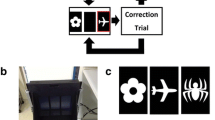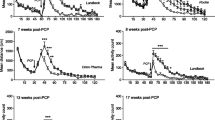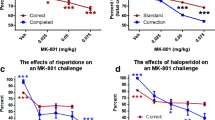Abstract
Rationale
Currently available antipsychotics are unsatisfactory given their side effects and limited efficacy for the cognitive symptoms of schizophrenia. Many currently available drugs, such as haloperidol, are T-type calcium channel antagonists in addition to their well-established antagonism of dopamine D2 receptors. Thus, preclinical research into the effects of T-type calcium channel antagonists/blockers in behavioral assays related to schizophrenia may inform novel therapeutic strategies.
Objectives
We explored the effects of a recently developed highly selective T-type calcium channel antagonist, Z944 (2.5, 5.0, 10.0 mg/kg), on the MK-801 (0.15 mg/kg) model of acute psychosis.
Methods
To examine the effects of Z944 on behaviors relevant to schizophrenia, we tested touchscreen-based paired associates learning given its relevance to the cognitive symptoms of the disorder and locomotor activity given its relevance to the positive symptoms.
Results
Acute treatment with Z944 failed to reverse the visuospatial associative memory impairments caused by MK-801 in paired associates learning. The highest dose of drug (10.0 mg/kg) given alone produced subtle impairments on paired associates learning. In contrast, Z944 (5.0 mg/kg) blocked the expected increase in locomotion following MK-801 treatment in a locomotor assay.
Conclusions
These experiments provide support that Z944 may reduce behaviors relevant to positive symptoms of schizophrenia, although additional study of its effects on cognition is required. These findings and other research suggest T-type calcium channel antagonists may be an alternative to currently available antipsychotics with less serious side effects.




Similar content being viewed by others
References
Andiné P, Widermark N, Axelsson R, Nyberg G, Olofsson U, Mårtensson E, Sandberg M (1999) Characterization of MK-801-induced behavior as a putative rat model of psychosis. J Pharmacol Exp Ther 290(3):1393–1408
Bisagno V, Raineri M, Peskin V, Wikinski SI, Uchitel OD, Llinás RR, Urbano FJ (2010) Effects of T-type calcium channel blockers on cocaine-induced hyperlocomotion and thalamocortical GABAergic abnormalities in mice. Psychopharmacology 212(2):205–214
Brown AS, Vinogradov S, Kremen WS, Poole JH, Deicken RF, Penner JD, … Schaefer CA (2009) Prenatal exposure to maternal infection and executive dysfunction in adult schizophrenia. Am J Psychiatr 166(6):683–690
Bussey TJ, Holmes A, Lyon L, Mar AC, McAllister KAL, Nithianantharajah J, … Saksida LM (2012) New translational assays for preclinical modelling of cognition in schizophrenia: the touchscreen testing method for mice and rats. Neuropharmacology 62(3):1191–1203
Cadinu D, Grayson B, Podda G, Harte MK, Doostdar N, Neill JC (2018) NMDA receptor antagonist rodent models for cognition in schizophrenia and identification of novel drug treatments, an update. Neuropharmacology. https://doi.org/10.1016/j.neuropharm.2017.11.045
Chen CC, Shen JW, Chung NC, Min MY, Cheng SJ, Liu IY (2012) Retrieval of context-associated memory is dependent on the Ca v3.2 T-type calcium channel. PLoS One 7(1):1–10
Choi K-H (2013) The design and discovery of T-type calcium channel inhibitors for the treatment of central nervous system disorders. Expert Opin Drug Discovery 8(8):919–931
Choi KH, Rhim H (2010) Inhibition of recombinant Cav3.1 (α1G) T-type calcium channels by the antipsychotic drug clozapine. Eur J Pharmacol 626(2–3):123–130
Crunelli V, David F, Leresche N, Lambert RC (2014) Role for T-type Ca2+ channels in sleep waves. Pflugers Arch Eur J Physiol 466(4):735–745
De Rover M, Pironti VA, McCabe JA, Acosta-Cabronero J, Arana FS, Morein-Zamir S, … Sahakian BJ (2011) Hippocampal dysfunction in patients with mild cognitive impairment: a functional neuroimaging study of a visuospatial paired associates learning task. Neuropsychologia 49(7):2060–2070
Egan MF, Zhao X, Smith A, Troyer MD, Uebele VN, Pidkorytov V, Cox K, Murphy M, Snavely D, Lines C, Michelson D (2013) Randomized controlled study of the T-type calcium channel antagonist MK-8998 for the treatment of acute psychosis in patients with schizophrenia. Hum Psychopharmacol Clin Exp 28(2):124–133
Enyeart JJ, Biagi B a, Mlinar B (1992) Preferential block of T-type calcium channels by neuroleptics in neural crest-derived rat and human C cell lines. Mol Pharmacol 42(2):364–372
Gangarossa G, Laffray S, Bourinet E, Valjent E (2014) T-type calcium channel Cav3.2 deficient mice show elevated anxiety, impaired memory and reduced sensitivity to psychostimulants. Front Behav Neurosci 8(March):1–12
Goff DC, Falkai P, Fleischhacker WW, Girgis RR, Kahn RM, Uchida H, … Lieberman JA (2017) The long-term effects of antipsychotic medication on clinical course in schizophrenia. Am J Psychiatr 174(9):840–849
Green MF (2006) Cognitive impairment and functional outcome in schizophrenia and bipolar disorder. J Clin Psychiatry 67(SUPPL. 9):3–8
Henbid MT, Marks WN, Collins MJ, Cain SM, Snutch TP, Howland JG (2017) Sociability impairments in genetic absence epilepsy rats from Strasbourg: reversal by the T-type calcium channel antagonist Z944. Exp Neurol 296:16–22
Howland JG, Cazakoff BN, Zhang Y (2012) Altered object-in-place recognition memory, prepulse inhibition, and locomotor activity in the offspring of rats exposed to a viral mimetic during pregnancy. Neuroscience 201:184–198
Joksimovic SM, Eggan P, Izumi Y, Joksimovic SL, Tesic V, Dietz RM, … Todorovic SM (2017) The role of T-type calcium channels in the subiculum: to burst or not to burst? J Physiol 595(19):6327–6348
Kim CH, Heath CJ, Kent BA, Bussey TJ, Saksida LM (2015) The role of the dorsal hippocampus in two versions of the touchscreen automated paired associates learning (PAL) task for mice. Psychopharmacology 232(21–22):3899–3910
Kraus RL, Li Y, Gregan Y, Gotter AL, Uebele VN, Fox SV, … Renger JJ (2010) In vitro characterization of T-type calcium channel antagonist TTA-A2 and in vivo effects on arousal in mice. J Pharmacol Exp Ther 335(2):409–417
Lee M (2014) Z944: a first in class T-type calcium channel modulator for the treatment of pain. J Peripher Nerv Syst 19(S2):S11–S12
Leeson VC, Robbins TW, Matheson E, Hutton SB, Ron MA, Barnes TR, Joyce EM (2009) Discrimination learning, reversal, and set-shifting in first-episode schizophrenia: stability over six years and specific associations with medication type and disorganization syndrome. Biol Psychiatry 66(6):586–593
Lencz T, Malhotra AK (2015) Targeting the schizophrenia genome: a fast track strategy from GWAS to clinic. Mol Psychiatry 20(7):820–826
Lieberman JA, Stroup TS, McEvoy JP, Swartz MS, Rosenheck RA, Perkins DO, Keefe RS, Davis SM, Davis CE, Lebowitz BD, Severe J (2005) Effectiveness of antipsychotic drugs in patients with chronic schizophrenia. N Engl J Med 353(12):1209–1223
Lins BR, Howland JG (2016) Effects of the metabotropic glutamate receptor 5 positive allosteric modulator CDPPB on rats tested with the paired associates learning task in touchscreen-equipped operant conditioning chambers. Behav Brain Res 301:152–160
Lins BR, Phillips AG, Howland JG (2015) Effects of D- and L-govadine on the disruption of touchscreen object-location paired associates learning in rats by acute MK-801 treatment. Psychopharmacology 232(23):4371–4382
Marks WN, Cain SM, Snutch TP, Howland JG (2016a) The T-type calcium channel antagonist Z944 rescues impairments in crossmodal and visual recognition memory in genetic absence epilepsy rats from Strasbourg. Neurobiol Dis 94:106–115
Marks WN, Greba Q, Cain SM, Snutch TP, Howland JG (2016b) The T-type calcium channel antagonist Z944 disrupts prepulse inhibition in both epileptic and non-epileptic rats. Neuroscience 332:121–129
Marks WN, Parker ME, Zabder NK, Greba Q, Snutch TP, Howland JG (2018) T-type calcium channels in the orbitofrontal cortex mediate sensory integration as measured using a spontaneous oddity task in rats. Learn Mem 25(7):317–324
McCollum LA, Roberts RC (2015) Uncovering the role of the nucleus accumbens in schizophrenia: a postmortem analysis of tyrosine hydroxylase and vesicular glutamate transporters. Schizophr Res 169(1–3):369–373
McCormick PN, Kapur S, Graff-Guerrero A, Raymond R, Nobrega JN, Wilson AA (2010) The antipsychotics olanzapine, risperidone, clozapine, and haloperidol are d2-selective ex vivo but not in vitro. Neuropsychopharmacology 35(8):1826–1835
Moore H, Geyer MA, Carter CS, Barch DM (2013) Harnessing cognitive neuroscience to develop new treatments for improving cognition in schizophrenia: CNTRICS selected cognitive paradigms for animal models. Neurosci Biobehav Rev 37(9):2087–2091
Nicholl D, Akhras KS, Diels J, Schadrack J (2010) Burden of schizophrenia in recently diagnosed patients: healthcare utilisation and cost perspective. Curr Med Res Opin 26(4):943–955
Nithianantharajah J, Komiyama NH, McKechanie A, Johnstone M, Blackwood DH, Clair DS, … Grant SGN (2013) Synaptic scaffold evolution generated components of vertebrate cognitive complexity. Nat Neurosci 16(1):16–24
Nithianantharajah J, McKechanie AG, Stewart TJ, Johnstone M, Blackwood DH, St Clair D, … Saksida LM (2015) Bridging the translational divide: identical cognitive touchscreen testing in mice and humans carrying mutations in a disease-relevant homologous gene. Sci Rep 5(August):14613
Roberts DL, Velligan DI (2012) Medication adherence in schizophrenia. Drug Discovery Today: Therapeutic Strategies 8(1–2):11–15
Robinson TG, Beart PM (1988) Excitant amino acid projections from rat amygdala and thalamus to nucleus accumbens. Brain Res Bull 20(4):467–471
Roebuck AJ, Liu MC, Lins BR, Scott GA, Howland JG (2018) Acute stress, but not corticosterone, facilitates acquisition of paired associates learning in rats using touchscreen-equipped operant conditioning chambers. Behav Brain Res 348:139–149
Roschlau C, Votteler A, Hauber W (2016) Stimulant drug effects on touchscreen automated paired-associates learning (PAL) in rats. Learn Mem 23(8):422–426
Santi CM, Cayabyab FS, Sutton KG, McRory JE, Mezeyova J, Hamming KS, … Snutch TP (2002) Differential inhibition of T-type calcium channels by neuroleptics. J Neurosci 22(2):396–403
Sendt KV, Tracy DK, Bhattacharyya S (2015) A systematic review of factors influencing adherence to antipsychotic medication in schizophrenia-spectrum disorders. Psychiatry Res 225(1–2):14–30
Siegrist R, Pozzi D, Jacob G, Torrisi C, Colas K, Braibant B, … Bezençon O (2016) Structure-activity relationship, drug metabolism and pharmacokinetics properties optimization, and in vivo studies of new brain penetrant triple T-type calcium channel blockers. J Med Chem 59(23):10661–10675
Stafford MR, Mayo-Wilson E, Loucas CE, James A, Hollis C, Birchwood M, Kendall T (2015) Efficacy and safety of pharmacological and psychological interventions for the treatment of psychosis and schizophrenia in children, adolescents and young adults: a systematic review and meta-analysis. PLoS One 10(2):1–17
Talley EM, Cribbs LL, Lee JH, Daud A, Perez-Reyes E, Bayliss DA (1999) Differential distribution of three members of a gene family encoding low voltage-activated (T-type) calcium channels. J Neurosci 19(6):1895–1911
Talpos JC, Aerts N, Fellini L, Steckler T (2014) A touch-screen based paired-associates learning (PAL) task for the rat may provide a translatable pharmacological model of human cognitive impairment. Pharmacol Biochem Behav 122:97–106
Talpos J, Aerts N, Waddell J, Steckler T (2015) MK-801 and amphetamine result in dissociable profiles of cognitive impairment in a rodent paired associates learning task with relevance for schizophrenia. Psychopharmacology 232(21–22):3911–3920
Tringham E, Powell KL, Cain SM, Kuplast K, Mezeyova J, Weerapura M, … Snutch TP (2012) T-type calcium channel blockers that attenuate thalamic burst firing and suppress absence seizures. Sci Transl Med 4(121):121ra19–121ra19
Uslaner JM, Smith SM, Huszar SL, Pachmerhiwala R, Hinchliffe RM, Vardigan JD, … Hutson PH (2012) T-type calcium channel antagonism produces antipsychotic-like effects and reduces stimulant-induced glutamate release in the nucleus accumbens of rats. Neuropharmacology 62(3):1413–1421
Wang G, Bochorishvili G, Chen Y, Salvati KA, Zhang P, Dubel SJ, Perez-Reyes E, Snutch TP, Stornetta RL, Deisseroth K, Erisir A, Todorovic SM, Luo JH, Kapur J, Beenhakker MP, Zhu JJ (2015) CaV3.2 calcium channels control NMDA receptor-mediated transmission: a new mechanism for absence epilepsy. Genes Dev 29:1535–1551
Winship IR, Dursun SM, Baker GB, Balista PA, Kandratavicius L, Maia-de-oliveira JP, … Howland JG (2018) An overview of animal models related to schizophrenia. Can J Psychiatr in press
Yilmaz Z, Zai CC, Hwang R, Mann S, Arenovich T, Remington G, Daskalakis ZJ (2012) Antipsychotics, dopamine D2receptor occupancy and clinical improvement in schizophrenia: a meta-analysis. Schizophr Res 140(1–3):214–220
Zamponi GW (2016) Targeting voltage-gated calcium channels in neurological and psychiatric diseases. Nat Publ Group 15(1):19–34
Zhang Y, Llinas RR, Lisman JE (2009) Inhibition of NMDARs in the nucleus reticularis of the thalamus produces delta frequency bursting. Frontiers in Neural Circuits 3(November):1–9
Acknowledgements
This research was supported by an operating grant from the Canadian Institutes of Health Research (CIHR) to JGH (#125984). Work in the laboratory of TPS is supported by an operating grant from CIHR (#10677), the Canada Research Chair in Biotechnology and Genomics-Neurobiology and the Koerner Foundation. Matching funds for these experiments were provided by the Saskatchewan Health Research Foundation and the University of Saskatchewan. AJR received salary support from the Natural Sciences and Engineering Research Council of Canada Collaborative Research and Training Program (NSERC CREATE). WNM is supported by funding from the Saskatchewan Health Research Foundation. MCL received an award from the Natural Sciences and Engineering Research Council of Canada Undergraduate Student Research Award Program. NBT received salary support from the College of Medicine, University of Saskatchewan.
Author information
Authors and Affiliations
Corresponding author
Ethics declarations
Conflict of interest
On behalf of all authors, the corresponding author states that there is no conflict of interest.
Rights and permissions
About this article
Cite this article
Roebuck, A.J., Marks, W.N., Liu, M.C. et al. Effects of the T-type calcium channel antagonist Z944 on paired associates learning and locomotor activity in rats treated with the NMDA receptor antagonist MK-801. Psychopharmacology 235, 3339–3350 (2018). https://doi.org/10.1007/s00213-018-5040-3
Received:
Accepted:
Published:
Issue Date:
DOI: https://doi.org/10.1007/s00213-018-5040-3




